The bird dog exercise is a widely recognized and effective core-strengthening exercise that targets multiple muscle groups, including the abdomen, lower back, and glutes. It is named after the way dogs stretch and extend their limbs, resembling a bird dog pointing at its prey. This exercise is commonly incorporated into fitness routines, rehabilitation programs, and yoga practices due to its ability to improve core stability, balance, and posture.
How to perform the bird dog exercise correctly
To perform with proper form, follow these step-by-step instructions:
- Start by positioning yourself on all fours, with your hands aligned directly under your shoulders and your knees directly under your hips. Ensure that your spine is in a neutral position, maintaining a straight line from your head to your tailbone.
- Engage your core muscles by drawing your navel toward your spine. This activation will help stabilize your torso throughout the exercise.
- Begin the movement by extending your right arm forward, reaching it out in front of you. At the same time, extend your left leg backward, straightening it out behind you. Both your arm and leg should be parallel to the floor.
- Focus on maintaining a straight line from your fingertips to your toes, ensuring that your hips remain level and parallel to the ground. Avoid any excessive arching or rounding of your back.
- Hold this extended position for a few seconds, feeling the engagement in your core, glutes, and back muscles.
- Slowly return to the starting position by bringing your arm and leg back to the tabletop position simultaneously.
- Repeat the movement on the opposite side by extending your left arm forward and your right leg backward.
- Continue alternating sides for the desired number of repetitions or as recommended by your fitness routine.
Video tutorial:
To help you visualize the proper form and execution of the bird dog exercise, refer to the following demonstration:
By following these guidelines and performing the bird dog exercise correctly, you can effectively engage your core muscles, improve stability, and enhance your overall physical fitness. Incorporating this exercise into your routine can yield significant benefits for your posture, spinal health, and injury prevention.
Learn more: “Glute Kickbacks: Comprehensive Guide and FAQs + Video tutorial”
What muscles does the bird-dog exercise work?
This is a dynamic movement that engages and strengthens several key muscle groups, particularly focusing on the core muscles, glutes, and lower back. Let’s take a closer look at the primary muscles targeted by the bird dog exercise and how they are effectively engaged during the movement.
Core Muscles:
The bird dog exercise is renowned for its ability to engage and strengthen the core muscles, which are essential for providing stability and support to the spine. The core muscles primarily targeted include:
- Rectus Abdominis: This is the front abdominal muscle responsible for flexing the spine and creating that desired “six-pack” appearance.
- Transverse Abdominis: This deep-lying muscle acts as a natural corset, wrapping around the abdomen to provide stability and support to the spine.
- Obliques: The internal and external obliques, located on the sides of the waist, are responsible for rotation and lateral flexion of the trunk.
Erector Spinae:
The erector spinae muscles are a group of deep muscles that run parallel to the spine, on both sides of the vertebral column. They play a vital role in extending and stabilizing the back. The bird dog exercise effectively engages the erector spinae, promoting strength and stability in the muscles supporting the spine.
Glutes:
The gluteal muscles, including the gluteus maximus, medius, and minimus, are activated during the bird dog exercise to provide stability and support to the hips and lower back. The glutes play a crucial role in maintaining balance and controlling hip movement during the extension of the leg in the exercise.
How the exercise engages and strengthens specific muscle groups:
During the bird dog exercise, the act of extending the arm and leg simultaneously requires coordination and balance, engaging multiple muscle groups to maintain proper form and stability. The exercise focuses on anti-rotation, anti-flexion, and anti-extension, meaning it challenges the core muscles to resist unwanted movement in various directions, leading to improved core strength and stability.
As you extend your arm forward, the core muscles, including the rectus abdominis, transverse abdominis, and obliques, work synergistically to prevent rotation and maintain a stable torso. Simultaneously, the erector spinae muscles engage to support the extension and stability of the spine.
The extension of the leg backward activates the gluteal muscles, primarily the gluteus maximus, which is the largest muscle in the gluteal group. These muscles work to control the movement of the leg, stabilize the hip joint, and maintain proper alignment.
Overall, this exercise provides a comprehensive workout for the core muscles, erector spinae, and glutes, leading to improved core strength, stability, and postural control. Regular practice of this exercise can contribute to better functional movement, reduced risk of lower back pain, and enhanced athletic performance.
What are the benefits of the bird-dog exercise?
This exercise offers a wide range of benefits for the body, making it a valuable addition to any fitness routine. Let’s explore the various advantages that this exercise provides:
Strengthening and stabilizing the core and lower back
This exercise primarily targets the core muscles, including the rectus abdominis, transverse abdominis, and obliques. These muscles work together to provide stability and support to the spine and pelvis. By regularly performing the bird-dog exercise, you can strengthen these muscles, leading to improved core strength and stability.
Improving posture, balance, and coordination
The bird-dog exercise promotes proper alignment and posture, as it requires maintaining a neutral spine position throughout the movement. By strengthening the core and postural muscles, this exercise helps improve overall posture and body awareness. It also enhances balance and coordination by challenging your ability to stabilize your body while extending your limbs.
Enhancing spinal health and reducing the risk of lower back pain or injury
The bird-dog exercise targets the erector spinae muscles, which run parallel to the spine and provide support to the back. Strengthening these muscles can improve spinal stability and reduce the risk of lower back pain or injury. By engaging the core muscles and promoting proper alignment, the bird-dog exercise supports a healthy spine and decreases the strain on the lower back.
Supporting other compound movements and athletic performance
A strong and stable core is essential for performing compound movements and athletic activities. The bird-dog exercise builds a solid foundation of core strength, which can improve your performance in exercises such as squats, deadlifts, and overhead presses. It also enhances overall athletic performance by improving stability, balance, and coordination.
Versatility and accessibility
The bird-dog exercise is a versatile exercise that can be modified to suit different fitness levels and goals. It can be performed by beginners as well as advanced individuals. The exercise requires minimal equipment and can be done anywhere, making it accessible for home workouts, gym sessions, or even while traveling.
Incorporating the bird-dog exercise into your fitness routine can yield significant benefits, both in terms of physical strength and overall well-being. Whether you are an athlete, a fitness enthusiast, or someone looking to improve their core stability and posture, the bird-dog exercise is an effective choice that can contribute to a stronger, more functional body.
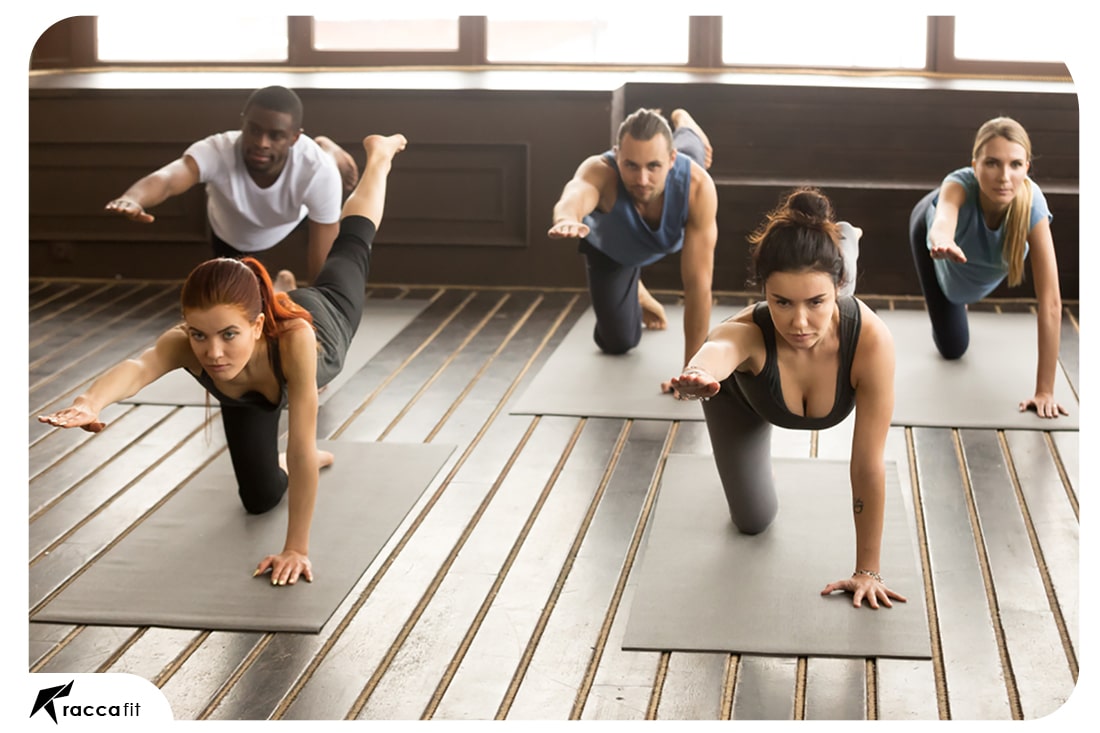
How many calories does a bird dog burn?
The bird dog exercise is primarily a strength and stability exercise rather than a high-intensity cardiovascular exercise. As such, its calorie-burning potential is relatively moderate compared to more intense aerobic activities. However, it can still contribute to overall calorie expenditure and aid in weight management when combined with a well-rounded fitness routine and a balanced diet.
The exact number of calories burned during the bird dog exercise can vary based on several factors, including body weight, intensity, duration, and individual fitness level. Here we can provide you with a plan customized to meet your exact nutritional needs, keep an eye for any food allergies, and create a meal plan no matter the dietary requirement but the following factors can influence calorie expenditure:
1. Body Weight: Heavier individuals tend to burn more calories during exercise because it requires more energy to move a larger mass. On the other hand, lighter individuals may burn fewer calories performing the same activity.
2. Intensity and Effort: The intensity at which the bird dog exercise is performed affects calorie expenditure. Engaging the core muscles and maintaining proper form throughout the exercise requires effort and energy expenditure. Performing the exercise with focus, control, and stability can increase calorie burn.
3. Duration: The duration of the exercise session also plays a role in calorie burn. Longer durations of continuous activity will generally result in higher calorie expenditure.
Approximate calorie estimation
While it is challenging to provide an exact number of calories burned during the bird dog exercise due to the individual variability mentioned above, we can provide a rough estimation based on averages.
On average, a person weighing around 155 pounds (70 kilograms) can expect to burn approximately 80-100 calories during 15 minutes of moderate-intensity bird dog exercise. For someone weighing 200 pounds (91 kilograms), the calorie burn may range from 100-130 calories during the same duration and intensity.
It is important to note that these numbers are estimates and can vary depending on the factors mentioned earlier. Additionally, incorporating the bird dog exercise into a comprehensive workout routine that includes a variety of exercises and cardiovascular activities will yield more significant overall calorie expenditure.
Remember, the primary benefits of the bird dog exercise lie in its ability to improve core strength, stability, and posture rather than its calorie-burning potential. To achieve optimal weight management and fitness goals, it is recommended to combine the bird dog exercise with other forms of exercise and maintain a healthy and balanced diet.
Variations of the bird dog exercise
The bird dog exercise can be modified and progressed to add variety and challenge to your workout routine. Here are several variations of the bird dog exercise that you can incorporate to target different muscle groups, increase difficulty, or cater to specific fitness goals:
Bird dog plank
In this variation, instead of returning to the starting position after extending the arm and leg, hold the extended position for an extended period, creating a plank-like position. This variation increases the demand on the core muscles, requiring greater stability and strength.
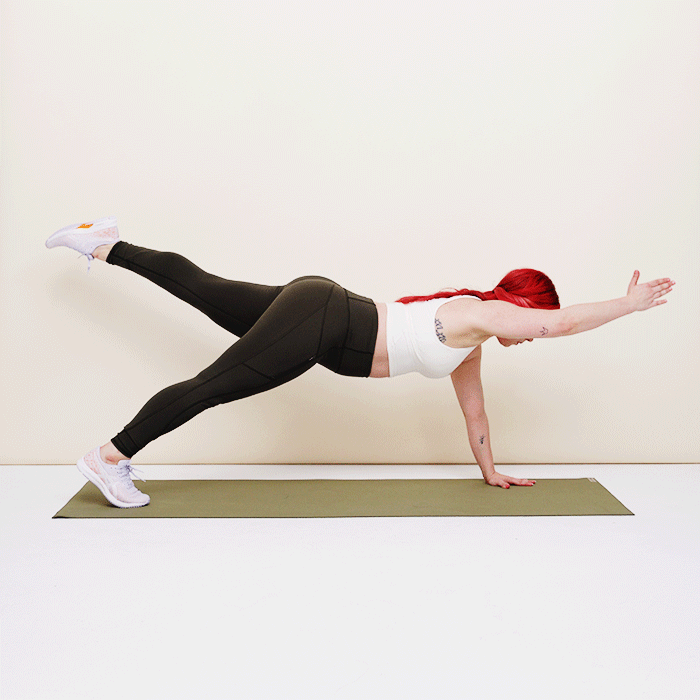
Bird dog with resistance band
To add resistance and increase the challenge, place a resistance band around your feet or ankles while performing the bird dog exercise. The band provides continuous tension throughout the movement, engaging the muscles more intensively.
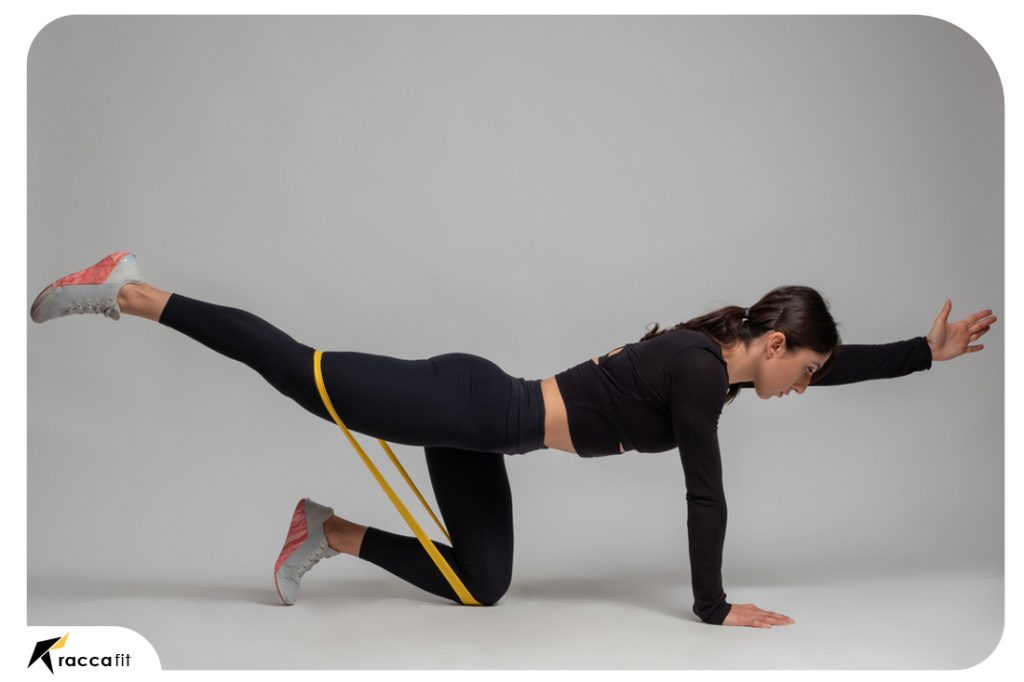
Bird dog row
Incorporate a rowing motion into the bird dog exercise by holding a dumbbell or kettlebell in one hand. As you extend the opposite arm and leg, pull the weight towards your body, engaging the back muscles in addition to the core and glutes. Alternate sides and repeat for the desired number of repetitions.

Elevated bird dog
Perform the bird dog exercise with your hands elevated on a step, bench, or yoga block. This variation increases the range of motion, further challenging the stability and strength of the core and glutes.
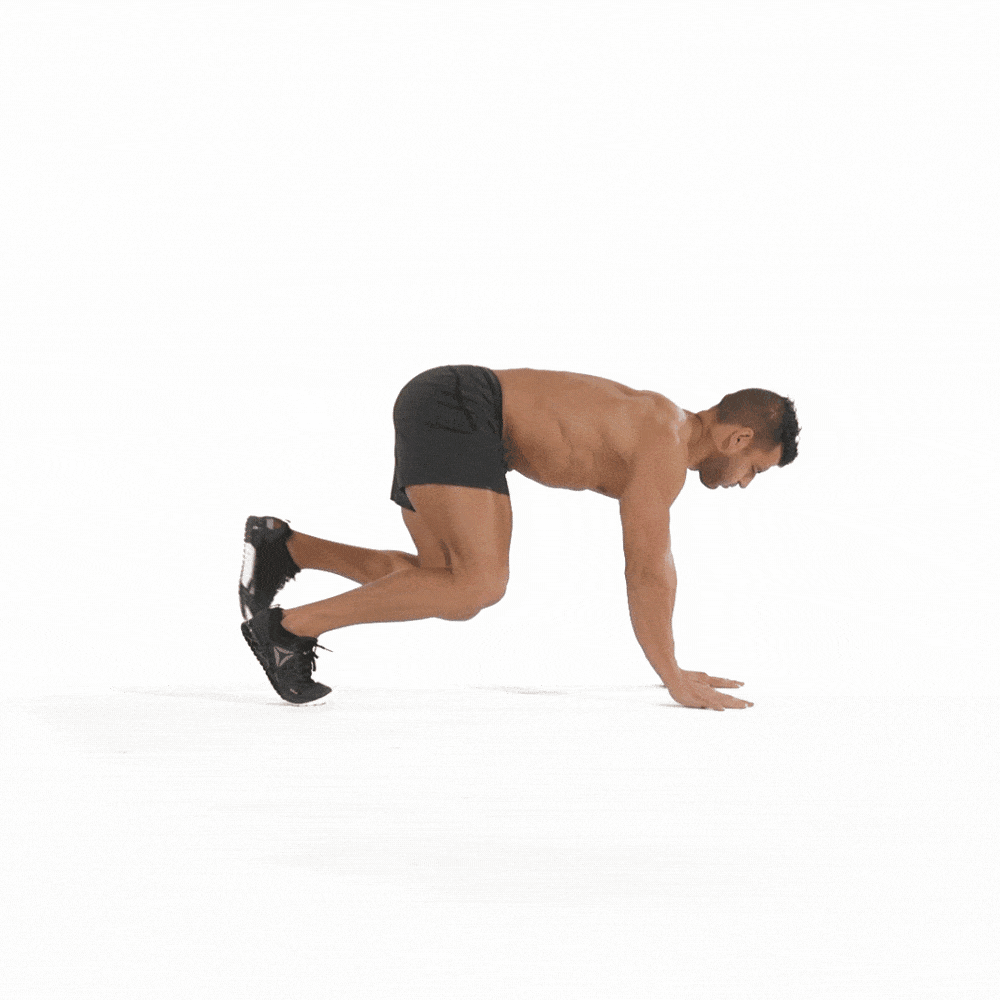
Single-leg bird dog
Focus on one side of the body at a time by performing the bird dog exercise with only one arm and the opposite leg extended. This variation increases the demand on the core muscles, as they work harder to maintain stability and balance with only three points of support.
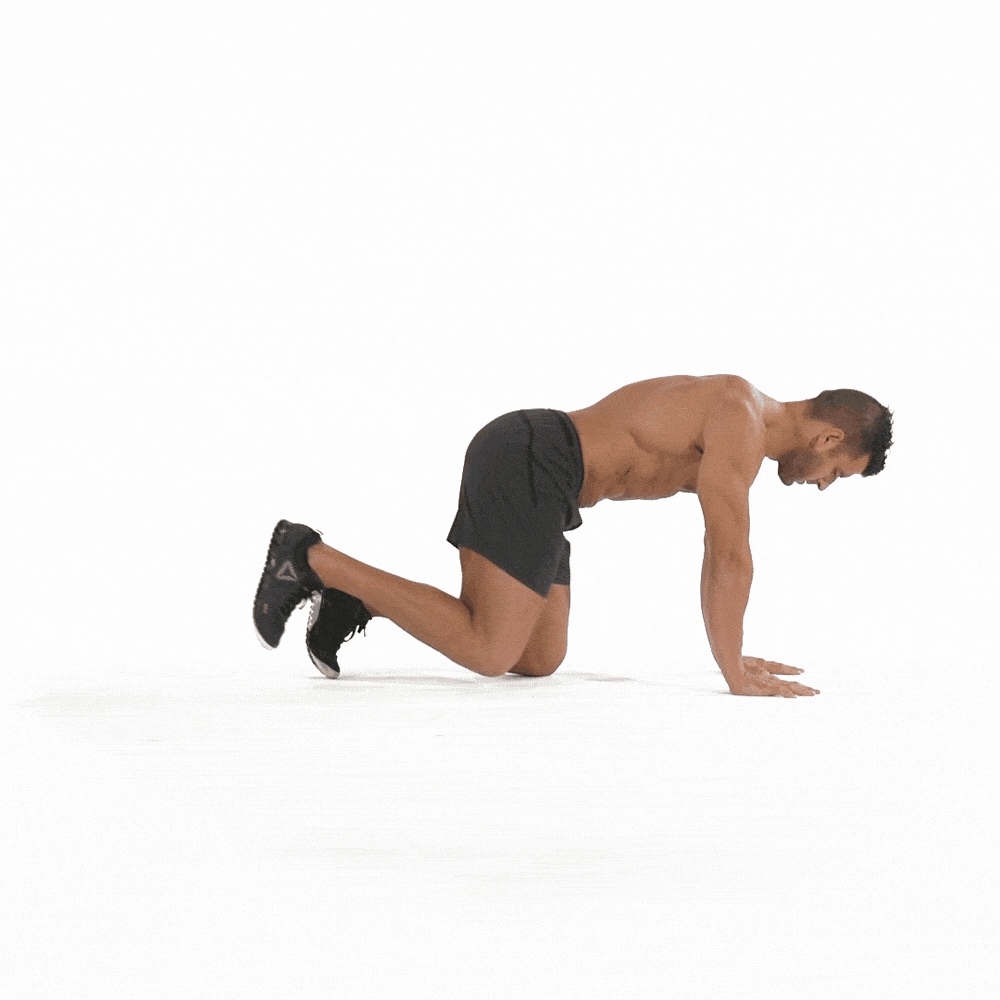
Dynamic bird dog
Instead of holding the extended position, perform the bird dog exercise with a fluid, dynamic motion. As you extend the arm and leg, smoothly transition into the opposite side without pausing, creating a flowing and continuous movement. This variation adds a cardiovascular element and enhances coordination.
Suggestions for skill levels and goals:
- Beginners: Start with the traditional bird dog exercise, focusing on proper form and stability. Gradually progress to other variations as you develop strength and coordination.
- Intermediate: Incorporate variations such as the bird dog plank, single-leg bird dog, or bird dog with resistance band to increase the challenge and target specific muscle groups.
- Advanced: Challenge yourself with more advanced variations like the bird dog row or elevated bird dog to further engage your muscles and enhance overall strength and stability.
- Rehabilitation or Physical Therapy: Modify the exercise based on individual needs and consult with a healthcare professional or physical therapist for personalized guidance.
Remember to prioritize proper form and listen to your body. Progress gradually and choose variations that align with your skill level and specific goals. By incorporating these variations, you can keep your workouts interesting, target specific muscle groups, and continue to challenge yourself as you progress in your fitness journey.
When to do the bird dog
The bird dog exercise can be incorporated into your workout routine in various ways, depending on your specific goals and preferences. Here are some recommendations on when and how to include the bird dog exercise:
Warm-up routine
The bird dog exercise can serve as an excellent warm-up exercise, preparing your body for more intense movements. It helps activate and engage the core muscles, promoting stability and increasing blood flow to the targeted muscle groups. Perform a few sets of bird dog exercises with controlled movements and focus on proper form to prepare your body for the upcoming workout.
Core-focused workouts
The bird dog exercise is an ideal addition to core-focused workouts. It targets the core muscles, including the abdominals, obliques, and erector spinae, effectively strengthening and stabilizing the core. Include multiple sets of bird dog exercises within your core routine to engage the muscles and enhance core strength and stability.
Rehabilitation or physical therapy
The bird dog exercise is commonly utilized in rehabilitation and physical therapy programs due to its ability to strengthen the core, stabilize the spine, and improve balance. If you are recovering from a lower back injury or seeking to improve your posture, incorporate the bird dog exercise under the guidance of a healthcare professional or physical therapist.
Cool-down and stretching
Performing the bird dog exercise during your cool-down routine can help bring your heart rate down gradually while still engaging the core muscles. It can be combined with other stretching exercises to improve flexibility and prevent muscle tightness. Include a few sets of bird dog exercises at a slower pace, focusing on controlled movements and deep breathing.
Versatility in training programs
One of the advantages of the bird dog exercise is its versatility and adaptability to different training programs. Whether you follow a strength training regimen, incorporate yoga or Pilates, or engage in functional training, the bird dog exercise can complement your existing routine. It can be included as a standalone exercise or incorporated within circuits or supersets.
Remember, the bird dog exercise can be customized based on your fitness level and goals. Beginners can start with the basic movement, gradually increasing repetitions and sets. Intermediate and advanced individuals can incorporate variations or progressions of the bird dog exercise to add challenge and complexity.
Lastly, listen to your body and be mindful of any discomfort or pain. If you experience any issues or have specific concerns, it is advisable to consult with a qualified fitness professional or healthcare provider for personalized guidance.
Incorporating the bird dog exercise strategically into your workout routine can help improve core strength, stability, and overall body control. Its versatility makes it a valuable exercise for a wide range of training programs and goals.

Bird dog sets and reps
Determining the appropriate sets and reps for the bird dog exercise depends on various factors, including your fitness level, goals, and overall workout structure. Here are some general guidelines and suggestions to help you plan your bird dog sets and reps:
1. Beginners: If you’re new to the bird dog exercise, start with a lower volume to allow your body to adapt to the movement and develop proper form and technique. Begin with 1-2 sets of 8-10 repetitions per side. Focus on maintaining control and stability throughout each repetition. As you become more comfortable and confident with the exercise, gradually increase the number of sets and repetitions.
2. Intermediate: Intermediate individuals who are familiar with the bird dog exercise can aim for 2-3 sets of 10-12 repetitions per side. This range allows for adequate muscle engagement and progression. Concentrate on executing each repetition with controlled movements, focusing on form and stability. If you’re looking for an additional challenge, consider incorporating variations of the bird dog exercise or increasing the intensity by adding resistance bands or weights.
3. Advanced: Advanced individuals who have mastered the basic bird dog exercise can perform 3-4 sets of 12-15 repetitions per side. You may choose to maintain a higher volume or increase the intensity by incorporating more challenging variations or increasing resistance. Advanced practitioners can also explore dynamic bird dog exercises, where you flow smoothly from one side to the other without pausing, adding a cardiovascular element to the exercise.
Tips for gradually increasing intensity or volume:
- Increase repetitions: Gradually add 1-2 repetitions per week to challenge your muscles and progress over time.
- Add sets: Once you feel comfortable with your current sets and repetitions, add an additional set to increase overall volume and workload.
- Incorporate variations: Introduce different variations of the bird dog exercise to engage the muscles in different ways and add complexity to your routine.
- Increase resistance: Use resistance bands or weights to add resistance and intensify the exercise. Start with light resistance and gradually progress to heavier loads.
- Control tempo: Slow down the movement and focus on the quality of each repetition. This can enhance the time under tension and increase the difficulty.
It’s important to listen to your body and avoid overexertion or pushing yourself beyond your capabilities. Gradually progress the intensity, volume, or complexity of the bird dog exercise to challenge your muscles while maintaining proper form and avoiding injury.
Always prioritize quality over quantity when performing the bird dog exercise. Focus on engaging the correct muscles, maintaining stability, and performing the movement with control. Proper form and technique are key to maximizing the benefits of the exercise and reducing the risk of injury.
Consult with a qualified fitness professional if you have any specific concerns, physical limitations, or require personalized guidance in determining the most appropriate sets, reps, and progression for your individual needs.
Common bird dog mistakes
While the bird dog exercise is a highly effective core-strengthening exercise, there are common mistakes that people often make. Understanding and correcting these mistakes is crucial to ensure the exercise is performed correctly and to maximize its benefits while minimizing the risk of injury. Here are some common bird dog mistakes to watch out for:
Arching or rounding the back
One of the most common mistakes is allowing the back to arch or round during the movement. Arching the back can place excessive stress on the lower back, while rounding the back reduces the engagement of the core muscles. Both can compromise proper form and decrease the effectiveness of the exercise.
Correction: Maintain a neutral spine throughout the exercise. Imagine a straight line running from your head to your tailbone. Engage your core muscles and avoid excessive arching or rounding by focusing on keeping your torso stable and aligned.
Collapsing the shoulders or hunching the shoulders
Allowing the shoulders to collapse or hunch forward can limit the engagement of the core and back muscles, reducing the effectiveness of the exercise. It can also lead to improper alignment and potential strain on the shoulder joints.
Correction: Keep your shoulders in line with your wrists and avoid hunching or collapsing them. Imagine spreading your shoulder blades apart, creating space between them. This will help maintain proper alignment and engage the muscles of the upper back.
Lifting the leg too high or extending the arm too far
Exaggerating the movement by lifting the leg too high or extending the arm too far beyond a parallel position to the floor can compromise stability and proper muscle engagement. It shifts the focus away from the core muscles and increases the risk of losing balance.
Correction: Focus on controlled and intentional movements. Keep the leg and arm parallel to the floor, maintaining a straight line from fingertips to toes. Avoid excessive extension to maintain stability and maximize engagement of the core and glute muscles.
Neglecting core engagement
Failing to engage the core muscles throughout the exercise is a common mistake. Without proper core activation, the exercise becomes less effective in strengthening the core and stabilizing the spine.
Correction: Prioritize core engagement throughout the entire movement. Draw your navel towards your spine, activating the deep abdominal muscles, such as the transverse abdominis. Maintain this engagement throughout the exercise to enhance stability and maximize the benefits for the core muscles.
Lack of stability and control
Performing the bird dog exercise with momentum or lack of control can reduce the effectiveness of the exercise and increase the risk of injury. Rapid and uncontrolled movements limit muscle engagement and compromise stability.
Correction: Focus on controlled movements and stability. Slow down the pace of the exercise, emphasizing the quality of each repetition. Maintain control and stability throughout the movement to effectively engage the core and other targeted muscles.
Remember, proper form and technique are crucial to reap the full benefits of the bird dog exercise and minimize the risk of injury. To perform the exercise correctly:
- Maintain a neutral spine.
- Keep the shoulders aligned with the wrists.
- Avoid excessive leg or arm movements.
- Engage the core muscles throughout the exercise.
- Perform the exercise with controlled and intentional movements.
By being mindful of these common mistakes and implementing the suggested corrective measures, you can ensure that you perform the bird dog exercise properly and maximize its effectiveness in strengthening the core, improving stability, and reducing the risk of injury.

Who should do the bird dog
This exercise is suitable for a wide range of individuals, from beginners to advanced fitness enthusiasts. Here’s an explanation of the target audience and considerations for different fitness levels and specific populations:
Target Audience: This exercise is beneficial for individuals who want to strengthen their core, improve stability, enhance posture, and reduce the risk of lower back pain or injury. It can be incorporated into various fitness routines, including general strength training, rehabilitation programs, yoga practices, or functional training.
Beginners: This exercise is an excellent choice for beginners due to its simplicity and effectiveness. It helps establish a solid foundation of core strength and stability. Beginners can start with the basic bird dog exercise, focusing on proper form, stability, and control. Gradually increase the number of repetitions and sets as strength and confidence improve.
Intermediate and Advanced Individuals: This exercise can be adapted to provide a challenge for intermediate and advanced individuals. They can incorporate variations, such as the bird dog plank, elevated bird dog, or bird dog with resistance bands or weights, to increase difficulty and engage the muscles in different ways. These variations add complexity and intensity, allowing individuals to progress and continue to benefit from the exercise.
Considerations for specific populations
While this exercise is generally safe for most individuals, there are a few considerations and precautions for specific populations:
- Pregnant Women: Pregnant women can perform the bird dog exercise, but they should consult with their healthcare provider for guidance. Modifications may be necessary to accommodate the changes in the body during pregnancy.
- Individuals with Lower Back Issues: The bird dog exercise can be beneficial for individuals with lower back issues, but it’s important to start with caution and work within pain-free ranges of motion. Consulting with a healthcare provider or a qualified fitness professional can provide specific guidance based on individual needs.
- Injury or Medical Conditions: Individuals with specific injuries or medical conditions should seek guidance from a healthcare provider or a qualified fitness professional before incorporating the bird dog exercise. They can provide modifications or alternative exercises to suit individual circumstances.
It’s important to listen to your body, start at an appropriate level, and progress gradually. If you have any concerns, specific limitations, or pre-existing medical conditions, consult with a healthcare provider or a qualified fitness professional to ensure that the bird dog exercise is safe and suitable for your individual needs.
The bird dog exercise offers a versatile and effective way to improve core strength, stability, and overall body control. By considering individual fitness levels, following proper form, and addressing specific considerations, the bird dog exercise can be beneficial for a wide range of individuals.
Learn more: “Benefits of Running: Why It’s One of the Best Forms of Exercise”
Other exercises similar to bird dog
In addition to the bird dog exercise, there are several other exercises that target similar muscle groups and offer comparable benefits. Here are a few exercises that share similarities with the bird dog exercise:
1. Dead Bug: The dead bug exercise focuses on core stabilization and strengthening. It involves lying on your back with your arms and legs raised, mimicking the movement of a dead bug. By maintaining a neutral spine and engaging the core, you challenge your stability and improve core strength. The dead bug exercise is particularly beneficial for improving core control and stability during movement.
2. Plank: The plank is a classic core exercise that targets the abdominals, back, and shoulder muscles. It involves holding a straight body position, supported by the forearms and toes. Planks improve core strength, stability, and endurance. There are various plank variations, such as the forearm plank, high plank, side plank, and plank with leg lifts, allowing you to target different muscle groups within the core.
3. Supermans: Supermans focus on strengthening the lower back and glute muscles. It involves lying face down on the ground and lifting your arms and legs simultaneously, mimicking the flight position of Superman. This exercise helps strengthen the erector spinae muscles, glutes, and posterior chain. Supermans improve lower back stability, posture, and spinal health.
4. Pallof Press: The Pallof press is an anti-rotation exercise that targets the core and oblique muscles. It involves standing or kneeling while holding a cable or resistance band with both hands in front of your chest. By resisting the rotational force, you engage the core muscles to maintain stability. The Pallof press improves core strength, stability, and anti-rotational control.
Incorporating these exercises
To create a well-rounded workout routine, consider incorporating these exercises alongside the bird dog. We can help you to build a workout plan tailored to your goals, preferences, schedule, and available equipment in this page but here are some suggestions:
-
-
- Warm-up: Begin with dynamic movements like the bird dog exercise, dead bug, or supermans to activate the core and prepare the body for exercise.
- Core Workout: Combine the bird dog exercise with planks, dead bugs, and Pallof presses to target different aspects of core strength and stability. Perform multiple sets and repetitions of each exercise, focusing on proper form and engagement.
- Strength Training: Include exercises such as squats, lunges, deadlifts, and rows to complement the core work and target other muscle groups.
- Cool-down: End your workout with static stretches, including stretches for the core and lower back muscles, to promote flexibility and relaxation.
-
Remember to adjust the intensity, sets, and repetitions based on your fitness level and goals. Always prioritize proper form, engage the appropriate muscles, and listen to your body to avoid injury.
By incorporating a variety of exercises that target the core, lower back, and stabilizing muscles, you can create a well-rounded workout routine that improves overall strength, stability, and functional movement.
Conclusion
The bird dog exercise is a versatile and effective way to strengthen the core, lower back, and glutes. It improves core stability, posture, and reduces the risk of lower back pain. Whether you’re a beginner or advanced, the bird dog exercise can be tailored to your fitness level.
Proper form is essential to maximize benefits and avoid injury. Avoid common mistakes like arching or rounding the back and engage the core throughout. Incorporating exercises like the dead bug, plank, supermans, and Pallof press can complement the bird dog exercise for a well-rounded core workout.
Remember to listen to your body, progress gradually, and consult professionals if needed. Incorporating the bird dog exercise and related exercises will lead to a stronger, more stable body. Start incorporating the bird dog exercise into your routine and enjoy the benefits of a stronger core and improved posture.
FAQs
1. How do I perform the bird dog exercise correctly? To perform the bird dog exercise with proper form, follow the step-by-step instructions provided, ensuring alignment, core engagement, and controlled movements. Refer to the video tutorial for visual guidance.
2. What muscles does the bird dog exercise target? The bird dog exercise engages and strengthens core muscles, including the rectus abdominis, transverse abdominis, obliques, and erector spinae. It also activates the gluteal muscles, contributing to improved core stability and posture.
3. What are the benefits of the bird dog exercise? The bird dog exercise offers benefits such as strengthening and stabilizing the core and lower back, improving posture, balance, and coordination, enhancing spinal health, and supporting compound movements and athletic performance.
4. How many calories does a bird dog exercise burn? While the bird dog exercise is primarily a strength and stability exercise, it can contribute to overall calorie expenditure. The exact calories burned vary based on factors like body weight, intensity, and duration, with an estimated range provided in the article.
5. Are there variations of the bird dog exercise? Yes, the article introduces various bird dog exercise variations such as the bird dog plank, bird dog with resistance band, bird dog row, elevated bird dog, single-leg bird dog, and dynamic bird dog. These variations cater to different skill levels and fitness goals.









1 thought on “Bird dog exercise: Comprehensive guide and video tutorial”
Great exercise 👊